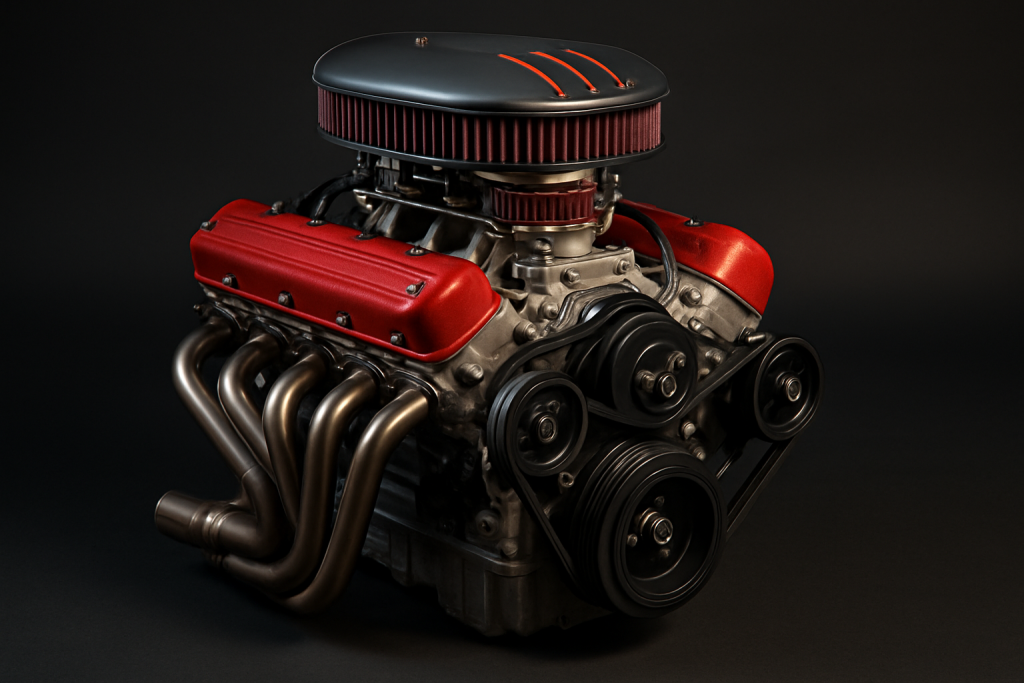⏲️ Estimated reading time: 5 min
Biggest V8 Engine in Racing History
Discover the most powerful and massive V8 engines ever used in motorsports, from NASCAR monsters to Can-Am legends. These mechanical beasts reshaped racing history with raw horsepower, speed, and sound that shook the ground beneath them.
🏁 The Biggest V8 Engines in Racing History
When it comes to motorsports, few things excite fans more than the thunderous roar of a V8 engine. These iconic powerplants have become the heart and soul of racing across disciplines NASCAR, Formula 1 (in its earlier days), endurance racing, and especially Can-Am. Let’s take a deep dive into the biggest and baddest V8 engines that ever tore up the racetrack.
🔧 1. Chevrolet 8.1L (496 ci) V8 Can-Am Beast
In the 1970s, the Canadian-American Challenge Cup (Can-Am) featured virtually no engine restrictions, leading to the development of some monstrous V8s. Among them was the Chevrolet 8.1-liter big-block, used in McLaren M8F and other Can-Am cars.
- Power Output: Over 800 horsepower
- Torque: Massive low-end grunt
- Notable Car: McLaren M8F
- Highlight: Combined with a lightweight chassis and no turbo lag, these V8s made Can-Am cars some of the fastest of their time.

⚡ 2. Ford 427 FE V8 – NASCAR Icon
The Ford 427 FE engine became a racing legend in the 1960s, dominating NASCAR, Le Mans, and drag strips alike.
- Displacement: 7.0L (427 cubic inches)
- Horsepower: ~600 hp (racing trim)
- Notable Car: Ford Galaxie, Shelby Cobra, GT40 Mk II
- Legacy: Helped Ford win Le Mans in 1966, beating Ferrari.

🚗 3. Chrysler 426 HEMI – “The Elephant Engine”
Known for its huge size and hemispherical combustion chambers, the 426 HEMI became a staple of drag racing and NASCAR.
- Displacement: 7.0L (426 ci)
- Nickname: “The Elephant” due to its massive size
- Output: 600+ hp in race trim
- Notable Car: Plymouth Superbird, Dodge Daytona
- Fun Fact: Banned from NASCAR in 1965 for being too dominant.
🏎️ 4. Mercedes-Benz M120 V8 (6.0L) – GT1 Racing
This naturally aspirated 6.0L V8 powered the Mercedes CLK GTR, a homologation special and one of the most brutal GT1 cars ever built.
- Horsepower: 600+ hp
- Notable Feature: Incredible high-revving nature and reliability
- Racing Series: FIA GT Championship
- Legacy: Part of the golden era of GT1, a category that blurred the lines between supercars and prototypes.
🦾 5. McLaren M8B with Chevy V8 – Can-Am Domination
In 1969, Bruce McLaren drove the M8B fitted with a 7.0L Chevy V8 to total Can-Am domination.
- Horsepower: ~670 hp
- Car Weight: Around 1,600 lbs
- Result: Won 11 out of 11 races in 1969
- Significance: Set the tone for unrestricted horsepower in Can-Am.

🔥 Honorable Mentions
- BMW S62B50 5.0L V8 – Used in BMW M5 E39 and adapted for racing (though not the largest, notable for its performance and innovation).
- Ferrari 4.5L V8 in 458 GT3 – One of the most successful GT racing V8s ever.
- Toyota TRD 5.9L V8 – Used in NASCAR’s modern era with competitive performance and durability.
📊 Why V8s Were So Dominant
V8s offered a perfect balance between size, power, and complexity. They could be naturally aspirated for instant power or supercharged for monstrous outputs. With fewer moving parts than a V12, they were often more reliable and easier to maintain in the grueling conditions of motorsports.
🧠 Fun Fact
The Can-Am series in the early 1970s featured V8 engines so large and powerful that some cars had over 1,000 hp, making them faster than Formula 1 cars of the same era. Engineers even experimented with twin-turbocharged V8s pushing past 1,500 hp well before the term “hypercar” existed.
🎧 What Does the Biggest V8 Sound Like?
The sound of a Can-Am big-block Chevy V8 is deafeningly raw, unfiltered, and primal. Unlike modern turbocharged engines, these beasts had no mufflers, just straight headers firing into the open air. You didn’t just hear them you felt them in your chest.
🚀 Are There Bigger Engines Than V8s in Racing?
Yes, V10s, V12s, and even V16s have appeared in racing (e.g., BRM V16, or early Cadillac Le Mans concepts), but V8s have maintained dominance for decades due to their versatility, cost-efficiency, and tunability.
🏁 Final Thoughts: A Legacy of Power
From the dirt ovals of NASCAR to the unforgiving road courses of Can-Am, big V8s have left a thunderous legacy. While electric motors are making their way into racing, nothing quite captures the raw emotion and mechanical brilliance like the rumble of a high-powered V8.
🔔 For more tutorials like this, consider subscribing to our blog.
📩 Do you have questions or suggestions? Leave a comment or contact us!
🏷️ Tags: V8 engines, racing history, Can-Am, NASCAR, Chevrolet V8, Ford 427, HEMI engine, GT1 racing, Mercedes CLK GTR, big block engines
📢 Hashtags: #V8Power #RacingEngines #MotorsportHistory #CanAm #NASCARLegends #ChevyBigBlock #Ford427 #HEMI426 #GT1Cars #EngineAddicts
🔚 Power on the Track: The Legacy of Racing V8s
The roar of a mighty V8 remains an unforgettable part of racing heritage. Whether you’re a fan of classic muscle, Can-Am innovation, or NASCAR thunder, one thing is clear bigger was better when it came to raw horsepower.
Only logged-in users can submit reports.
Discover more from HelpZone
Subscribe to get the latest posts sent to your email.

